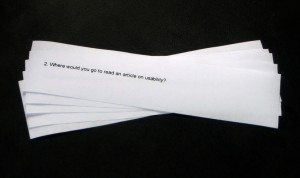Moderated, task-based testing is the mainstay of usability testing. There are a lot of other usability evaluation methods – and some people discourage using tasks altogether – but task-based testing remains a method most practitioners are familiar with and many use on a regular basis.
For my testing I typically prepare and print out a script that gives structure to the session and allows me to take notes on each question and task. This document is for my own use only and I don’t give it to the participant.
In standard testing I give each task verbally to the participant. In recent sessions I have experimented with also giving them a printed copy of the same task, one task at a time:
I have listed some potential pros and cons of this approach below.
Pros of printed tasks:
- Allows you to include additional context or background information with the task
- Participant can easily refer the printed task if they need to confirm anything
- Repeating the same task in writing helps understanding
- Printout helps clarify the task if you have an accent, like I do
Cons of printed tasks:
- Potentially less freedom for the participant to interpret the task and explore the site or application
- Increases the risk of word-matching as participant may cross-reference the task with the screen or wireframe
- More paper shuffling
Based on a limited sample most participants (more than half) do not actually refer the printed task at all and go with what you’ve told them to do. This would indicate that the printout is used for support only, as intended.
All in all I am not yet fully convinced with printed tasks but I will keep on experimenting.
If you decide to try printing out your tasks please let me know how you go!
Ps. Read Suze Ingram’s excellent post on How to take great notes during user testing sessions if you haven’t already.

Printing out the tasks was something we were taught to do at school. Maybe it’s the truth according to Nielsen, can’t remember.
I’ve done it both ways and have had similar experiences. Printing out the taks gives more structured and professional impression which is good if the product being tested is almost ready and the tasks are well structured.
At earlier stages when the product is at more or less prototype level, it often feels more appropriate to go with verbal tasks.
I would be careful, not to use too small pieces of thin paper as they quickly get untidy.
Thanks Matias, some great points there. Good tip on the paper size and weight, too!
Cheers, Jussi